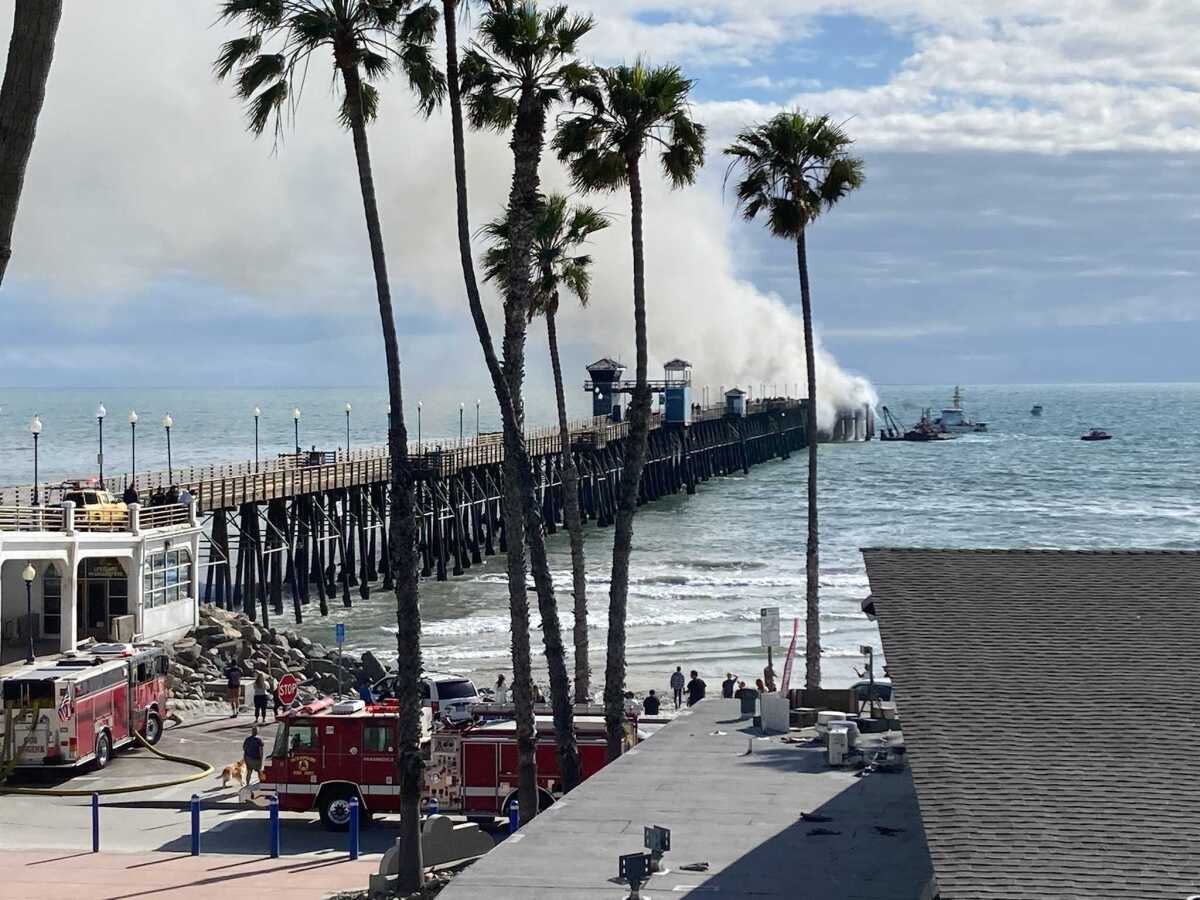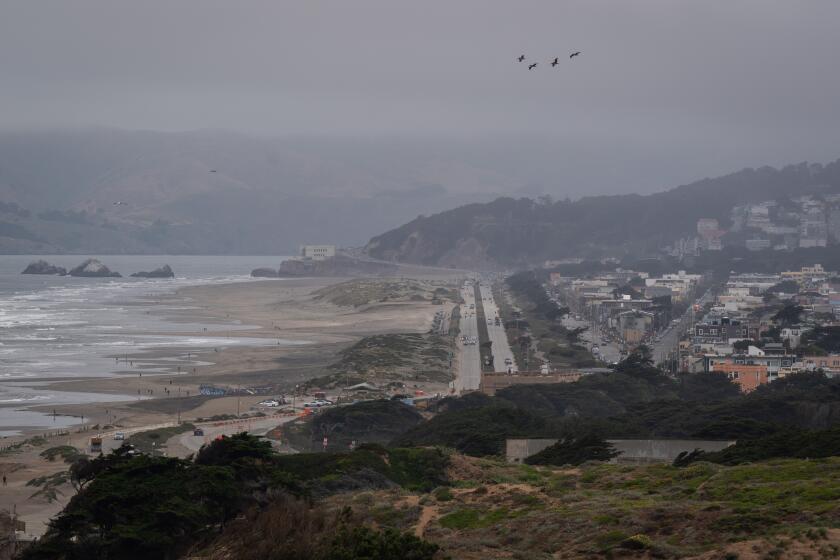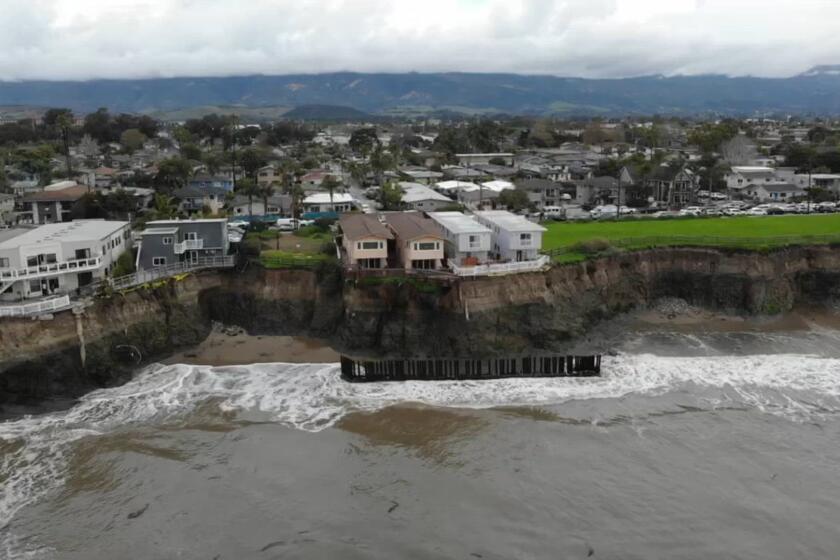Fire marks Oceanside Pier’s latest chapter in a troubled history

Firefighters have contained a fire that engulfed the end of the Oceanside Pier, a local landmark that has been destroyed by fire and storms and rebuilt several times in its 136-year history.
On Friday, the wood pylons of the 1,954-foot wooden structure were still smoldering from the blaze that ignited Thursday, officials said. No injuries were reported.
Oceanside and Strand beaches are still closed to the public as an environmental group cleans up the debris that has washed ashore. The fire also damaged a vacant restaurant that used to be Ruby’s Diner and a snack shop that housed the Brine Box, a seafood eatery.
“90% of the pier was saved thanks to a really quick response,” Oceanside city Public Information Officer Terry Gorman Brown said. “A lot of times when piers catch, they’re made of wood — they’re toast.”
The structure sits so high above the water that the sea spray couldn’t dampen the flames, she said.
“We don’t know [the cause] yet because until [the fire] is fully out we can’t really get out there,” said Brown.
California’s need for housing doesn’t require unraveling a legacy of balancing access, preservation and development at the beach.
The city engineer is assessing the damage and evaluating when the pier might reopen to the public.
This isn’t the first time the pier has caught fire. The last time was in 1976, when a blaze destroyed parts of the pier’s fish market, according to Kristi Hawthorne, director of the Oceanside Historical Society, who wrote a brief history of the pier for the Oceanside Chamber of Commerce.
The wooden pier is the longest of its kind on the West Coast and has been rebuilt five times since it was first constructed in 1888, so many times that it may not be considered the same pier.
“It’s never the same pier,” said Hawthorne. “But in our hearts and in our minds, it’s still always the Oceanside Pier.”
The pier was originally built as a commercial shipping wharf to bring business to Oceanside, which was incorporated the year the pier opened. But two years later the wharf was destroyed in a large storm and rebuilt four years later as a sightseeing pier with iron pilings.
The pier has been torn down or damaged in storms multiple times. Today’s sixth iteration of the pier was built in 1987 at a cost of $5 million.
The worn nubs of the first wharf can still be seen at times in low tide, and other parts of the structure have managed to survive the test of time. The access bridge connecting pedestrians to the pier is almost 100 years old, and the city is using funding from a sales tax measure to help demolish and construct a new bridge that will be approximately three stories high and house restaurants and other businesses.
An apartment building balcony in Santa Barbara’s Isla Vista community cracked and is hanging off the edge of the bluff, which has been eaten away by coastal erosion over the past few decades.
Oceanside is still in the preliminary design phase of that plan, with the new building estimated to cost around $40 million.
Despite the pier’s battered history, Hawthorne said, the city’s residents have always been determined to rebuild because it is a part of the local identity.
“It is the pride of Oceanside,” said Hawthorne, who started researching the pier in 1987 as a volunteer with the Oceanside Historical Society.
The pier has been a part of landmark moments in Oceanside history. In 1916, a huge flood washed through San Diego County. Roadways and railroads were cut off from the area, Hawthorne said, and the pier was used to deliver emergency supplies by boat.
During World War II, the pier became a military lookout for enemy planes and submarines.
Hawthorne’s children have grown up visiting the pier and eating there on special occasions. She said local residents have their graduation photos taken overlooking the water. It’s one of the first places she recommends tourists visit.
“You take one of the most beautiful, iconic walks,” she said of the view from the pier.
The pier may need to be rebuilt again by 2037, as it has an estimated 50-year lifespan.
Its ever-changing nature adds to its charm, Hawthorne said.
“We’re not taking [the lates fire] as a loss,” she said. “It’s just a new chapter.”
More to Read
Sign up for Essential California
The most important California stories and recommendations in your inbox every morning.
You may occasionally receive promotional content from the Los Angeles Times.












